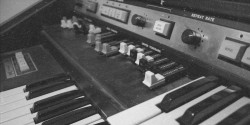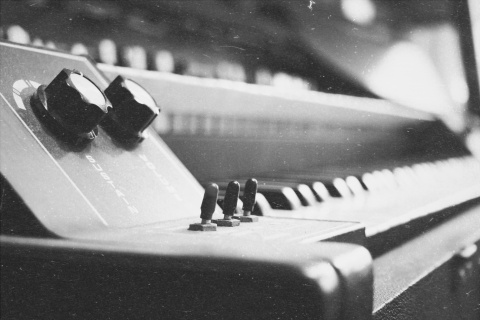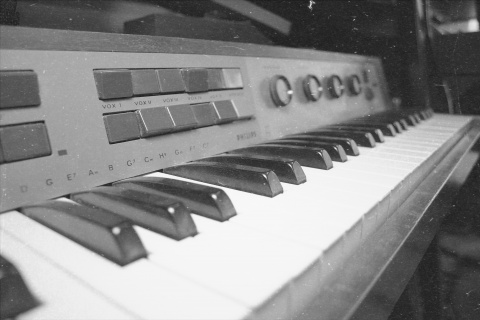
Small Museum - Big Collection
Ingo Elsner, a graduate of the Music Technology Specialist Bachelor and a true technophile, realized a small lifelong dream during his studies. Together with his like-minded wife, he created a digital museum called "The Very Tiny Museum", in which he presents his impressive collection of over 140 synthesizers, organs and keyboards piece by piece - conveniently online and accessible to everyone. In our interview, Ingo talks about the background to his project, all the exciting things he has planned for his museum in the future and, of course, everything that music and technology enthusiasts can already discover there!
POP: Let's start from the beginning - tell us about your time at POP!
Ingo: I did some sound courses at United POP Online, which allowed me to move on to the Bachelor Music Technology Specialist. I had dedicated lecturers and was able to learn a lot, so I was able to develop myself in my free time!
POP: One of your former lecturers drew our attention to your project. Tell us more about the very small museum!
Ingo: Of course you can admire the exhibits in the museum. We have added a product description for each device, as well as sound samples. The product catalog is still a work in progress, but I added some of our pieces last month. There is also a blog where we give regular updates on the project. In the podcast section, you can go straight to our podcast on the website, where we'll be talking about all sorts of things and doing interviews. In the book corner, we give a monthly book recommendation on the subject of music and sound. The project is still under construction at the moment, but we think it's moving in the right direction.

POP: That sounds exciting! Where did the idea of opening a museum come from?
Ingo: It all started with my first synthesizer 30 years ago. Now we have over 140 synthesizers and organs! We have stored many of the instruments in external warehouses or cellars and have wanted to centralize everything for some time. Originally, my wife and I wanted to open a physical museum, but we quickly came up against building regulations. Ventilation, escape routes and lighting are things we don't have the capacity for at the moment. Without an association or foundation behind it, it's utopian. But there is already a room with eight seats, a screen and a projector, where we can also occasionally welcome musicians, collectors and interested parties, almost like a house museum. Fortunately, digitization offers an alternative, and we decided to create an online collection first, which I then implemented as part of my bachelor's project.
POP: How did you get so many synthesizers?
Ingo: Music, sound and technology are my passion. Most of the devices wouldn't be affordable if I bought them new. But since I am technically gifted, I bought most of the devices broken or damaged and then repaired and restored them. As repairs are usually very expensive, I was able to save a lot of money. I have invested a lot of time and learned a lot in the process, which I can now pass on. That makes the whole thing even more personal and you are even more proud of your work.
POP: How much work is currently going into the project?
Ingo: As is so often the case with hobbies, the challenge here is to find a good amount of time and money to invest. At the moment, we are working about 10 hours a week on the project. We're already getting a lot of positive feedback, so we know that our work is paying off.

POP: What are your plans for the online museum?
Ingo: We are working on adding all our instruments to the website. I have already brought some experts, repairers, instrument makers, etc. on board as interview partners for the podcast, which will make everything even more lively and tangible. There will be a learning corner in the form of a wiki or glossary in which the most important terms can be looked up directly, backed up with scientific sources and documents. This will also include training paths and job profiles in this area, and there will also be interviews. I am also in contact with manufacturers and rights holders. The plan is to put some of my collected operating instructions, circuit diagrams and instrument manuals online. It is often difficult to find such things, especially when it comes to older models. It's a big chunk of work, which is legally very complex, so it's a slow start. In general, we want the museum to develop into a long-term place where you can learn, be amazed and advance your hobby.
POP: What role did your studies play in the realization of "The Very Tiny Museum"?
Ingo: I realized the website and sound samples as part of my bachelor's project. Of course, the sound samples were all recorded by myself. It was clear to me before the project that I wanted to create something that I could continue to work on. I think it's a shame if you do a project "just" for an exam and then don't get anything out of it later. I wanted to create a lasting work with which I could realize myself. That way, you not only achieve the learning objectives of your studies, but also pursue your own interests and can develop yourself further.
POP: Would that be something you could recommend to all prospective participants of the POP?
Ingo: Definitely. Always choose projects that you are passionate about. That way you have something that you can continue with enthusiasm after your studies.
We wish Ingo every success with his project and look forward to seeing how it develops in the future! Would you like to visit the museum yourself? You can find the website here:
